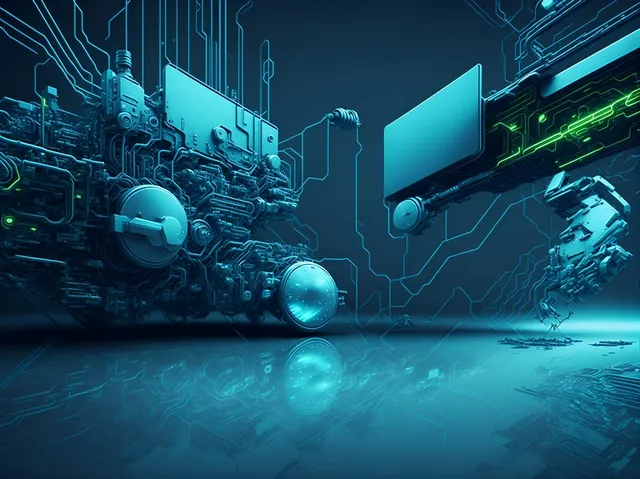Strategic Overview of the AI Technology Stack

In the swiftly advancing landscape of artificial intelligence, the line between market leaders and followers often rests on one pivotal element: the AI tech stack. This integrated collection of tools, frameworks, and platforms forms the bedrock of AI application development, ensuring robust, scalable, and efficient operations. As global AI adoption has surged from 50% six years ago to 72% today, understanding and optimizing your AI tech stack is more critical than ever.
Core Elements of an AI Tech Stack
AI development comprises multiple layers, each crucial for creating, deploying, and maintaining powerful AI systems. Here’s an in-depth look at the fundamental components:
Data Acquisition and Storage Solutions
Data is the lifeblood of AI initiatives, sourced from databases, APIs, sensors, and web scraping. Tools such as AWS Kinesis, AWS Glue, Azure Data Factory, and Databricks facilitate seamless data ingestion, ensuring a steady flow for analysis and model training. Storage solutions like Amazon S3, Google Cloud Storage, and Azure Blob Storage handle the data influx, providing scalable and secure repositories.
Data Preparation and Feature Engineering Techniques
Once collected, data undergoes cleansing, feature engineering, and transformation to enhance model performance. This stage ensures data relevance and readiness for training, involving techniques like normalization, scaling, and encoding to improve model accuracy and efficiency.
Algorithm Selection and Model Training
At the core of AI development is the selection of algorithms, model training, and fine-tuning for optimal performance. Whether deploying supervised learning for predictive tasks or unsupervised learning for pattern recognition, frameworks such as PyTorch, TensorFlow, and Keras offer the tools for building sophisticated neural networks. Hyperparameter optimization and performance evaluation metrics like accuracy and F1-score further refine model efficacy.
Model Deployment and Serving Infrastructure
Transitioning models from development to production requires robust infrastructure, typically leveraging Kubernetes, Docker, and serverless computing. Exposing models as APIs or microservices facilitates seamless integration and real-time interaction, supported by scalability strategies like load balancing.
Monitoring and Management Systems
Continuous post-deployment monitoring is crucial for maintaining model performance. Tools like PowerBI, Datadog, AWS CloudWatch, and Azure Monitor track key metrics, while alerting mechanisms enable swift anomaly detection. Version control systems like DVC ensure model traceability and reproducibility.
Computational Resources and AI Infrastructure
AI’s computational demands necessitate powerful resources, from CPUs and GPUs to specialized hardware. High-speed networking and efficient storage solutions like SSDs are pivotal, enabling swift data access and robust model management.
Development and Collaboration Environments
Development environments such as Jupyter Notebooks and PyCharm boost productivity, while version control systems like Git ensure codebase integrity and facilitate collaboration among team members.
Scalable Cluster Architectures
Cluster-based architectures provide scalability and high availability, optimizing resource utilization for demanding AI workloads. This flexibility is essential for adapting to varying project requirements.
The Role of Data in the AI Tech Stack
Data quality directly influences AI model performance, adhering to the GIGO principle (“garbage in, garbage out”). High-quality data ensures reliable outputs and model accuracy.
Varieties of Data in AI Projects
Structured Data: Organized and easily searchable, ideal for traditional analysis and machine learning.
Unstructured Data: Includes text, images, and videos requiring advanced techniques like NLP and computer vision.
Semi-structured Data: Formats like JSON that combine organization with flexibility.
Temporal Data: Time-stamped information critical for trend analysis and forecasting.
Spatial Data: Geographic information essential for applications like urban planning.
Data Handling: Collection, Preprocessing, and Augmentation
Data collection from diverse sources is followed by preprocessing to cleanse and standardize. Data augmentation techniques further enrich datasets, enhancing model resilience and performance.
Leading AI Development Frameworks
- PyTorch: Celebrated for its flexibility and dynamic computational graph, ideal for experimentation and complex AI solutions.
- TensorFlow: Google’s robust framework, offering extensive pre-built models and user-friendly interfaces for both beginners and experts.
- Keras: Known for its simplicity, running on top of TensorFlow, making it excellent for rapid prototyping.
Selecting the Optimal AI Framework
Project-specific needs, performance, scalability, ease of use, and integration with existing workflows should guide framework selection. Hands-on experimentation can help identify the best fit for your organization.
Best Practices for Constructing an AI Tech Stack
- Define Clear Objectives: Establish goals to guide development and measure success.
- Choose the Right Tools: Select tools that align with project requirements.
- Prioritize Data Quality: Ensure data accuracy and relevance.
- Focus on Scalability: Design architectures to handle growth.
- Embrace Automation: Streamline processes to boost efficiency.
- Promote Security and Privacy: Implement robust security measures.
- Foster Collaboration: Encourage teamwork across disciplines.
Conclusion: Building a Future-Ready AI Tech Stack
A well-constructed AI tech stack is pivotal for successful AI development and deployment. By leveraging the right tools, frameworks, and best practices, organizations can achieve high-performing, scalable AI solutions, maintaining a competitive edge in an increasingly AI-driven world.